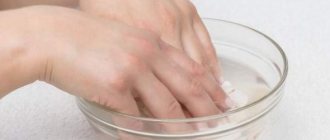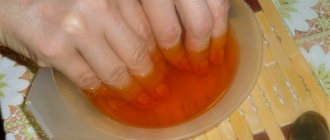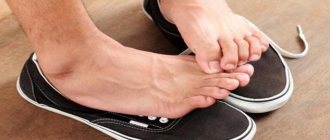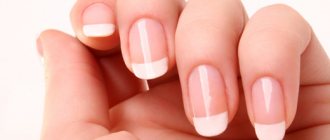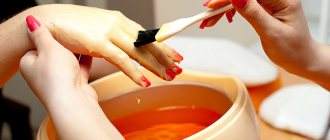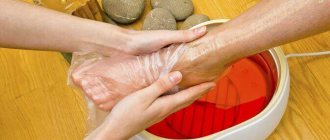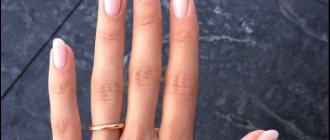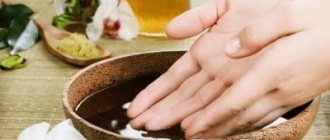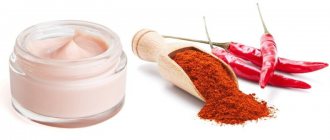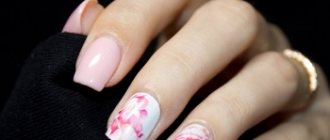The delicate skin of the hands is very vulnerable, as it is constantly exposed to negative external influences. To maintain health and youth, it is not necessary to undergo expensive cosmetic procedures in salons. An effective product can be found on any kitchen shelf. And this is ordinary baking soda (sodium bicarbonate, sodium bicarbonate).
Photo: Depositphotos.com. Author: EdZbarzhyvetsky.
Useful properties of the procedure
Soda solution has a healing effect on the skin of the hands and nails:
- disinfects;
- rejuvenates;
- softens rough areas;
- relieves inflammation;
- exhibits an antifungal effect;
- eliminates peeling;
- removes dead skin particles;
- relieves irritation and itching;
- strengthens and whitens nail plates.
Sodium bicarbonate is highly soluble in water, neutralizes the acidity of the skin environment, normalizing its acid-base balance (ph). Hence the bactericidal and antimycotic properties of the substance.
Soda is a sodium salt of carbonic acid (NaHCO3), which softens the skin and acts as a light peeling.
The maximum positive effect of baths can be achieved by combining it with other natural ingredients.
Antifungal effect
Hand fungus is a serious disease that causes discomfort and is contagious. To quickly defeat the disease, it is important to recognize it at the initial stage.
Changes in color, thickness, shape of the nail plate, brittleness and splitting of nails, itching and pain - these are the alarm signals sent by the body infected with the fungus.
If you notice these symptoms and there are no special antimycotic remedies at home, use baking soda baths as first aid.
Sodium bicarbonate helps fight fungus by providing a complex effect:
- cleans the surface of the nail;
- removes bacteria and fungal spores, prevents their reproduction;
- exfoliates damaged plate cells due to the peeling effect.
After getting rid of symptoms, soda baths are used to prevent relapses.
Attention! When solving dermatological problems, soda can only be used as an additional remedy, after first obtaining permission from a doctor.
Methods for treating nail fungus with soda.
Does baking soda help with nail fungus?
Baking soda is used as a local antiseptic for fungal nail infections without restrictions. After applying sodium bicarbonate, the affected tissue masses begin to better absorb medications. The unique substance is one of the rare agents whose action is directed and does not affect the skin. It is recommended to use soda for preventive purposes.
In the treatment of nail fungus, the effectiveness of sodium bicarbonate is due to its properties:
- cleanse the skin;
- disinfect;
- remove damaged areas.
Nail tissue keratinized as a result of onychomycosis is well treated with soda. This procedure is mandatory and preparatory during the treatment of nail fungus.
Soda has a disinfecting effect, helping to remove pathogenic bacteria that spread the disease. It continues to work even after disinfection.
Treatments with soda help soften nails and feet, making it easy to remove damaged skin and keratinized nail plates.
Using baking soda helps neutralize unpleasant odors, eliminate itching and remove flaking. Soda copes well with nail mycoses and is used for an unlimited time, since its correct use for the treatment of fungal nail disease cannot cause allergic reactions or other negative effects.
Video: AN INCREDIBLY budget WAY for treating fungus with BAKING SODA
For psoriasis and eczema
Psoriasis and eczema are common dermatological diseases that are characterized by irritation, burning, and extensive damage to the skin.
The use of soda is aimed at quickly restoring epidermal cells. NaHCO3 acts as a disinfectant and anti-inflammatory agent: it does not allow infection to penetrate deeper through open wounds, and helps prolong the period of remission.
For the bath, adhere to the ratio: 1 tsp. soda to 1 glass of warm water. If necessary, increase the volume of liquid while maintaining the original proportion. Immerse your hands in the solution for 20 minutes.
Antifungal baths
Usually, when dealing with fungi on the nails, it is not recommended to take any warm, wet baths, but there is one bath that, on the contrary, allows you to cope with this problem. If your nail plates are generally very susceptible to fungal infections, then this bath can also be done for preventive purposes.
A soap and soda bath is exactly what you need to fight fungus. To make it, you need to stir 1 tbsp in 250 ml of warm water. soda and flakes of grated soap. The procedure takes fifteen minutes. Then the hands are thoroughly dried. For therapeutic purposes, you can perform a course of ten daily procedures. And for preventive purposes, it is enough to do one procedure per week.
Successful combinations
The healing effect of sodium bicarbonate is enhanced in combination with other components:
- with sea salt - eliminates flaking, removes dead skin cells;
- with laundry soap - cleans, disinfects;
- with lemon - strengthens the nail plate, gives it a healthy shine, whitens the skin, helps get rid of hangnails;
- with essential oils - eliminates dryness and tightness, rejuvenates, nourishes.
- with apple or grape vinegar (only 1 drop per bath) - increases the permeability of cell membranes, stimulates nerve fibers in the skin, thereby accelerating cellular metabolism and regeneration; exhibits an antifungal effect and strengthens the nail plates.
- with aloe juice - moisturizes, fights dryness and irritation, helps heal microcracks.
- with ammonia - stimulates the hydration of epidermal cells, softens the skin, smoothes wrinkles, cleanses pores, and exhibits antiseptic properties.
- with glycerin - prevents premature aging, eliminates age-related pigmentation.
Bath recipes
Choose a recipe depending on what problem is bothering you.
Cleansing
Add 1 tsp to 1 liter of warm water. baking soda, ammonia, liquid soap. Immerse your hands in the liquid for 15 minutes. Blot with a napkin.
Whitening
Add 1 glass of milk + 1 glass of herbal infusion (chamomile, calendula, linden blossom or other medicinal herbs) to the soda solution (1 tsp per 1 liter of water). Action time: 15–20 minutes. Repeat the procedure twice a week.
Softening
Mixture 1 tsp. soda with a glass of oatmeal, pour 3 glasses of warm water. Immerse your hands in the bath for 20 minutes. Wash them and wipe them with a napkin.
Rejuvenating
Dissolve 1 tsp in a glass of water. soda, ½ tsp. ammonia, 25 ml each of liquid soap and glycerin. Soak your hands in the solution for 20 minutes, rinse. Dry with a towel.
With iodine for strong nails
Dissolve 1 tsp. sodium bicarbonate in a glass of water, add 5 drops of iodine there. Duration of the procedure: 20 minutes.
Antifungal
To eliminate fungus, add 1 tbsp to a glass of warm water. l. NaHCO3, ground soap flakes. Stir. Place your hands in the water for 15 minutes. Wipe dry.
Course of treatment: 10 procedures.
Restorative
Prepare a decoction: 2 tbsp. l. St. John's wort, chamomile and burdock root, pour 0.5 liters of water and boil for 10 minutes. Let cool. Add the broth to the soda bath. Immerse your hands in water for 20 minutes. Rinse and wipe dry.
To whiten your nails, you can try a mask: mix a little hydrogen peroxide or tooth powder and a pinch of soda. Apply to nails, rinse with water after 10 minutes.
How to use correctly
Depending on the location of the lesion and its area, various methods of treatment with soda should be used. Among the most effective methods of application are:
- Soda paste.
- Saturated sodium bicarbonate solution.
- Compresses based on the use of soda and its solutions.
- A combination of laundry soap and baking soda for complex treatment.
Soda paste
It should be used locally, applied to the affected area. To prepare, mix sodium bicarbonate and warm water in a 1:1 ratio.
In addition, due to the correct combination with other drugs, the effectiveness of treating fungal diseases can be increased. To prepare soda paste use:
- Aloe plant juice. It helps soften the skin and also has an antifungal effect.
- Hydrogen peroxide.
- Lemon juice.
With aloe
In order to prepare soda paste with aloe, you need to mix baking soda and water. You should get a consistency reminiscent of sour cream. Next, you need to add a couple of milliliters of aloe juice drop by drop. The juice should make up a third of the resulting paste.
Apply a small layer of soda paste with aloe to the affected areas. Experts recommend leaving the mixture overnight so that all components are thoroughly absorbed.
The paste should be used for several months until traces of the fungus disappear.
With hydrogen peroxide
Preparation of soda paste with peroxide:
- Mix a couple of glasses of water with baking soda in a ratio of (10/1). Pour a couple of drops of table bite into baking soda.
- Add one glass of peroxide and carefully move the resulting solution.
The solution is used for external use. The course of treatment should not exceed one and a half months.
With lemon juice
To prepare soda paste with lemon juice you need:
- Squeeze the juice from a whole lemon, remove the lemon seeds from the resulting solution.
- Prepare a paste of baking soda and juice by mixing both ingredients in a 1:1 ratio.
- The mass should resemble a creamy consistency.
For convenience, the resulting paste is secured with a bandage on the affected area. Because lemon juice is very drying to the skin, you should not use it too often.
Warm bath
Warm baths should be taken daily for several minutes. It is best to keep your feet or hands under water for half an hour. Warm baths should be taken before bed. This is necessary so that the remaining solution can be absorbed into the affected skin.
With water
In order to make a bath of baking soda with water, you should fill a bowl of hot water. Next, you should dissolve a couple of tablespoons of sodium bicarbonate. Then you need to immerse your hands or feet in the water, depending on the affected area.
You should stay in hot water for several minutes. As soon as the water cools down, you need to add hot water. Do not heat the water to high temperatures, otherwise you may get serious burns.
With iodine
It is necessary to prepare a warm bath with iodine at night. To do this, take a couple of glasses of water and dissolve the iodine solution in it. To obtain a rich color, add 10 drops for every 200 ml of water.
Next, you need to lower your hands or just your nails to achieve the effect. Such baths are often used when fungus forms on the nails. Warm baths should be done every evening until traces of fungus disappear.
With salt
A widely used method is taking warm baths with sea salt and sodium bicarbonate.
To do this, prepare a hot bath and add a couple of handfuls of sea salt to it. As soon as it dissolves in water, you need to pour in a soda solution. A solution of soda is prepared from water and sodium bicarbonate; they should be mixed in a ratio of 10:1.
Due to the high concentration of salts, it is not recommended to spend more than 20 minutes in the bath. It is also not worth using this method often, because the solution has a very aggressive effect on the skin and affected areas.
Saturated solution
If there is very little time to treat the fungus, you should prepare a saturated solution and make lotions. To prepare, you need to dissolve the maximum amount of baking soda in water.
Against candida
Baking soda copes well with the development of Candida fungus on nails, hair and skin. You can also use sodium bicarbonate to prevent the development of fungus.
Compresses
Soda compresses have disinfectant and anti-inflammatory properties. To do this, you need to moisten gauze in a soda solution and apply it to the affected area. For convenience, you should secure the gauze bandage with a bandage or paper adhesive plaster.
Laundry soap and soda
Laundry soap can be mixed with a soda solution to effectively treat fungus. To prepare, dilute laundry soap and sodium bicarbonate in hot water in a 1:1 ratio. Next, you need to immerse your legs or arms in the resulting solution, keeping them in the water for at least half an hour.
Rules for conducting procedures
- Before the procedure, wash your hands with soap and remove any remaining cream. If you want to work on your nails, remove the manicure polish.
- The water temperature should not exceed 40 °C, but not too cold. Focus on your feelings.
- The duration of the bath should not exceed 20 minutes.
- Optimal frequency: 2 times a week.
- After using the soda solution, carefully dry your hands with a paper napkin or soft towel, and apply a suitable cream.
Properties of soda and effect on fungus
Soda is called sodium bicarbonate (bicarbonate). This chemical compound is used in the food, light, chemical, pharmaceutical, non-ferrous metallurgy and medicine industries.
In folk medicine, soda is used to treat fungal nail infections. The effectiveness of the substance in this direction is explained by its disinfectant, anti-inflammatory, antiseptic, antipruritic and drying effect.
The effectiveness of soda in treating fungal infections is also due to its emollient properties. This allows the product to better act on tissues, penetrating deeply into their structure.
Reviews
Elena. I have very delicate skin on my hands. When I come into contact with household chemicals, I quickly feel dryness, irritation, and peeling. My sister suggested a recipe for a soda bath with iodine. I usually don’t use the product for longer than 10 minutes, but even during this time the effect is noticeable. The skin became soft and smooth, and thanks to iodine, the nails became stronger and grow faster.
Daria. I often work in the garden, but I’m used to doing everything without gloves. Of course, after gardening, the condition of the hands leaves much to be desired. I save myself with a simple soda bath without adding other ingredients. It makes the skin soft and perfectly removes impurities.
Anastasia. I was used to using a professional hand care line and didn’t really trust my friend when she talked about the positive effect of using soda. But it turned out that the baths rejuvenate and remove dryness no worse than expensive creams.
Stages of care
Complete hand skin care includes the following steps.
- Cleansing. For these purposes, use liquid soap or a bath with baking soda and soap.
- Peeling. Removing dead skin particles will provide access to subsequent cosmetic products. Use a regular store-bought scrub or make your own.
- Massage. Light stroking and rubbing using oil or hand cream will increase blood circulation and relax muscles.
- Homemade masks will help soften the skin, nourish it, and restore damaged tissue.
- Moisturizing is necessary to increase elasticity and create a protective barrier.
- Finger exercises will strengthen muscles and slow down aging.
Before looking for suitable hand products among the lines of expensive cosmetics, try budget soda baths.
The best recipes for soda foot baths.
